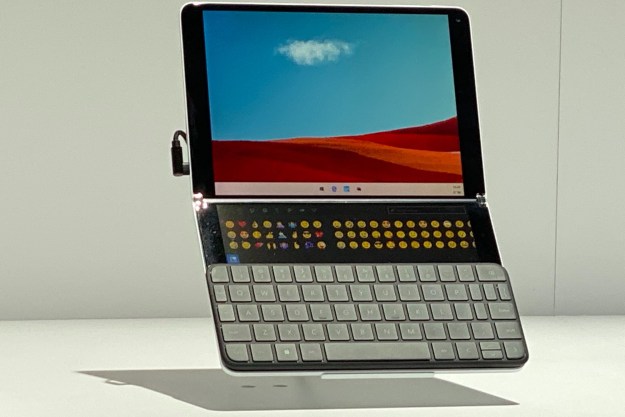
“Microsoft's Surface Neo is a bold new vision of the PC's future.”
- Extremely light
- Slick, simple design
- Two attractive screens
- Unique multi-mode keyboard
- Many details remain unknown
- Not arriving until late 2020
I just touched the future.
At Microsoft’s annual 2019 Surface hardware event, the company unveiled a new vision of the future. Code-named Centaurus, and officially known as the Surface Neo, it’s a new class of device, a dual screen, book-like gizmo that folds and unfolds, and converts, and in general does everything you’ve been waiting for your laptop to do. The company also unveiled a phone (finally!), a smaller, similar device called the Surface Duo.
In a back room, I was among the lucky few to lay hands on both.
Called the Surface Neo, the device is solid in the hands, slick under your fingers. It’s sleek. There’s no other word for it. With nary a button or notch to speak of, simply a Windows logo, the dual screens felt solid and substantial. Rather than a single panel that bends in the middle, this device has two 9-inch screens that expand to 13.1 inches when combined.
It’s sleek. There’s no other word for it.
Why not go with a folding screen, like Huawei, and Samsung, and the rest of the tech industry? Simple. Folding screens don’t go all the way around, and this device does, allowing for a variety of shapes and form factors. Well, that, and also…folding OLED displays haven’t proven reliable. The Samsung Galaxy Fold made that painfully obvious.
A polished metal seam (8.9 mm wide) runs between the two screens, hiding the hinge. Running a finger along it, I felt no bumps or deviations, and certainly no burrs or marks. Aside from a video camera (the device supports Windows Hello, of course, to let you log on through facial recognition), there’s not much to the hardware. It’s simple. Stark, even.
This fits in nicely with the vision of computing frequently described by Microsoft hardware guru Panos Panay. His concept? Hardware should fade into the background, enabling you to get to work. A perfect device is invisible, Panay claims.
Understand that this is a prototype. Concept hardware, even. But it felt exactly as Panay hoped, stark and invisible — allowing the software to shine, and your power to create to leap to the front. It feels transformative.

There’s accessories of course, including a Bluetooth keyboard and new version of the Surface pen. The keyboard is particularly awesome. It can magnetically attach to the back or front of the device, and when if folds over the screen, it enables a new mode, something Microsoft calls the Wonder Bar. The keyboard only covers half of the screen. The other becomes a text input area, a secondary display for a video, a picture-in-picture space, whatever you want.
Slide the keyboard to the top of the screen instead and the bottom piece becomes a trackpad, Microsoft says. Collectively, these different use modes are called Postures. The Wonder Bar and the trackpad were the only examples shown, but Microsoft presumably imagines more, since it bothered to give them a name.
Too often, we are held back by the fact that we have a single screen, without even realizing it. Consider Outlook: Not a day goes by when I don’t flip back and forth between calendar and mail to check whether I can take a meeting. I saw the Surface Neo open a calendar on one screen and mail on the other, and I was immediately puzzled by why no one has done this before. Why don’t all laptops have two screens?
Inside the device, the Neo runs Intel’s Lakefield chip, for now at least. Microsoft is likely to update the hardware when the device launches for the holiday season in 2020. And it’ll take some work and time for developers to truly take advantage of this device, which enables all sorts of wild new functionality. But the company is clear. This is not just a new gizmo, it’s a product category, and it fully expects traditional PC makers like HP, Asus, and others to jump on board.
I plan to as well. If this is the future of computing, I can’t wait for tomorrow.


